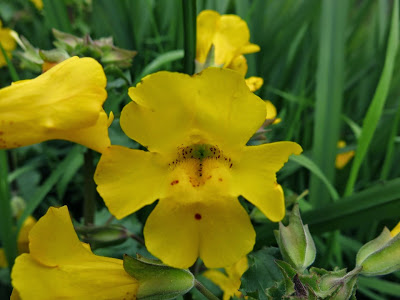
A Stirling scientist who discovered a new Scottish flower has made an unexpected second finding which provides unique insight into our understanding of evolution.
Dr Mario Vallejo-Marin, a Plant Evolutionary Biologist at the University of Stirling, first unearthed a new species of monkeyflower on the bank of a stream in South Lanarkshire, Southern Scotland in 2012.
A subsequent expedition two years later led Dr Vallejo-Marin to locate the impressive yellow flower some 350 miles north, near Stromness on the Orkney Islands off the north coast of Scotland.
“Orkney was a missing region which hadn’t been sampled,” explained Dr Vallejo-Marin, Senior Lecturer in the School of Natural Sciences. “There were different varieties of monkey flower on the island, but when we spotted this population I knew it was unusual as after looking at hundreds of plants, you get to recognise the subtle differences.
“Usually a species forms once in a particular location then spreads to other regions. In this case, the opposite has occurred as the same species has evolved multiple times in different places. It shows that when the conditions are right, the origin of species is a repeatable phenomenon.”
After the initial discovery, Dr Vallejo-Marin named the species Mimulus peregrinus – which translates as ‘the foreigner’ – given its origins from two invasive species first brought to the UK from the USA and South America in the 1800s.
It was a particularly rare find given hybrid plants of its kind are normally infertile. Instead, it doubled the amount of DNA in its cells and evolved to form a new species in a process known as polyploidisation, the same mechanism by which Wheat, Cotton and Tobacco originated.
Dr Vallejo-Marin added: “It is impossible to say whether Mimulus peregrinus evolved first in the south or in the north of Scotland, but our discovery of a very young species of this kind has allowed us to study evolution as it happens. We only know of a handful of other plant species as young as Mimulus peregrinus and so in this respect it is like looking at the big bang in the first milliseconds of its occurrence.
“The process of evolution it has followed is particularly interesting and adds complexity to our conception of the tree of life. Instead of branching out as it grows, Mimulus peregrinus is an example of how some branches can come back together again and spawn new species that are in part the combination of their ancestors.”
Dr Vallejo-Marin’s research is published in the Journal Evolution. The research was completed with UK colleagues from Queen Mary University of London and with Whitman College and the College of William and Mary in the USA.
Reference:
Mario Vallejo-Marín, Richard J. A. Buggs, Arielle M. Cooley andJoshua R. Puzey. Speciation by genome duplication: Repeated origins and genomic composition of the recently formed allopolyploid species Mimulus peregrinus. DOI: 10.1111/evo.12678
Note : The above story is based on materials provided by University of Stirling.










